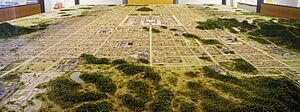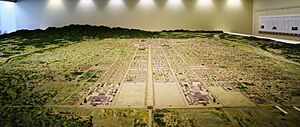Capital of Japan facts for kids
The capital of Japan is Tokyo. But did you know that Japan has had many different capitals throughout its long history? The very first capital of Japan was Nara.
Contents
History of Japan's Capitals
For a long time, the place where the Emperor lived was considered the capital. From the year 794 to 1868, the Emperor lived in a city called Heian-kyō, which is known today as Kyoto.
After 1868, a big change happened. The main offices of the Government of Japan and the Emperor's home moved to a city called Edo. This city was then renamed Tokyo. So, Tokyo became the new capital.
In 1941, Japan's Ministry of Education published a document. It talked about Tokyo being "designated" as the capital, using the Japanese term "Tōkyō-tento" (東京奠都). This was different from saying the capital was "relocated" to Tokyo.
Tokyo as the Modern Capital
Even today, there isn't one specific law that officially says Tokyo is the capital of Japan. However, many laws talk about a "capital area" called "shuto-ken" (首都圏), which includes Tokyo.
For example, the Capital Area Consolidation Law from 1956 says that the "capital area" includes Tokyo Metropolis and other nearby regions. This means the government sees Tokyo as the capital, even if it's not written in one single law. Other laws, like those for expressways or green spaces, also refer to this "capital area."
The word shuto, which means "capital" in Japanese, became common in the 1860s. It was used to explain the English word "capital." This term was never used for Kyoto, only for Tokyo.
In the past, there were ideas to move the capital away from Tokyo. In 1979, people started thinking about it, and in 1995, the parliament even voted on it! They looked at places north and south of Tokyo, and even near the old capitals like Nara and Kyoto. But in the end, the plans to move the capital were not carried out.
More recently, there's been talk about moving some government offices out of Tokyo, but keeping Tokyo as the main capital. This is called "capital functions relocation." For example, in 2023, the Agency for Cultural Affairs moved from Tokyo to Kyoto. This was the first time a central government office moved outside Tokyo since Tokyo became the capital.
Historical Capitals of Japan
Japan has a rich history with many different capital cities. The capital often moved with the Emperor's palace.
Early Historical Capitals (Kofun and Asuka Periods)
During the early periods of Japanese history, like the Kofun period and Asuka period, the capital moved quite often. These early capitals were usually in the Yamato region (modern-day Nara Prefecture) or nearby areas.
- Sakurai, Nara (Hatsuse no Asakura Palace), 457–479
- Hirakata, Osaka (Kuzuha Palace), 507–511
- Asuka, Yamato (Shikishima no Kanasashi Palace), 540–571
- Asuka, Yamato (Toyura Palace), 593–603
- Osaka (Naniwa Nagara-Toyosaki Palace), 645–654
- Ōtsu, Shiga (Ōmi Ōtsu Palace), 667–672
- Fujiwara-kyō (Fujiwara Palace), 694–710


Nara and Heian Periods
These periods are famous for their stable capital cities.
- Heijō-kyō (Heijō Palace), 710–740 and 745–784. This city is now known as Nara.
- Nagaoka-kyō (Nagaoka Palace), 784–794. This was a short-lived capital.
- Heian-kyō (Heian Palace), 794–1180. This city is modern-day Kyoto and was the capital for a very long time.


Medieval and Modern Capitals
- Heian-kyō or Kyōto (Heian Palace), 1180–1868. Kyoto remained the capital through many changes in Japan.
- Yoshino was a capital for a short time during a period of civil war (1336–1392).
- Tōkyō (Kōkyo), 1868–present. Tokyo has been the capital since the Emperor moved there.
Other Historical Capitals
Some other places were also capitals of independent or semi-independent regions in Japan's history:
- Hiraizumi was the capital of a powerful northern region called Ōshū from 1100 to 1189.
- Hakodate was the capital of a short-lived republic called the Republic of Ezo in 1869.
- Shuri was the capital of the Ryukyu Kingdom from 1429 to 1879. Before that, Urasoe was the capital of a kingdom called Chuzan from at least 1350.
See also
 In Spanish: Capital de Japón para niños
In Spanish: Capital de Japón para niños

